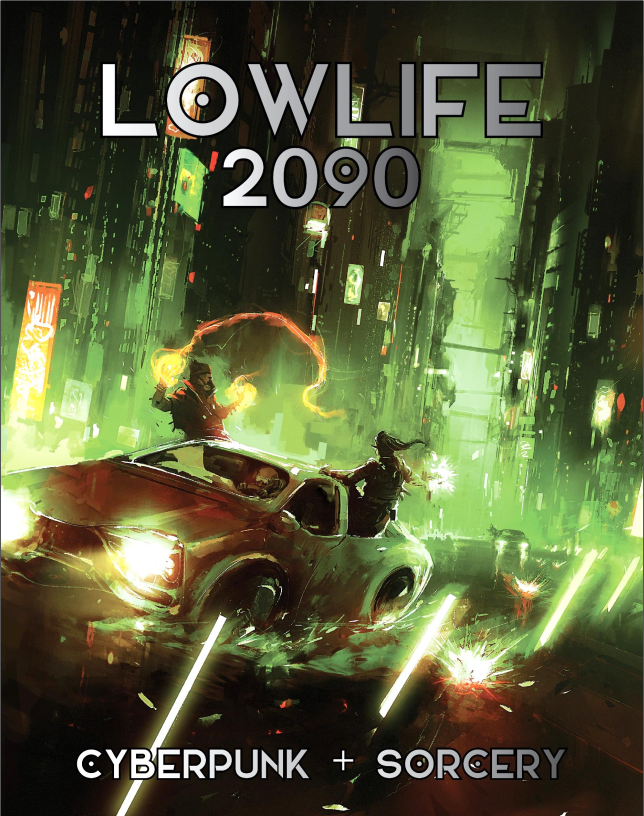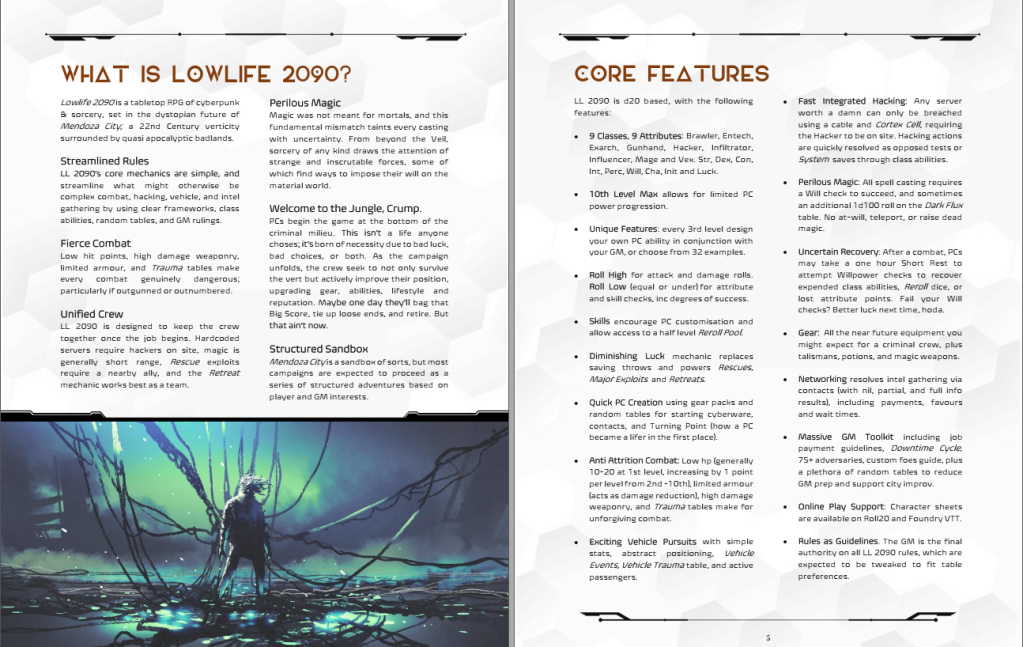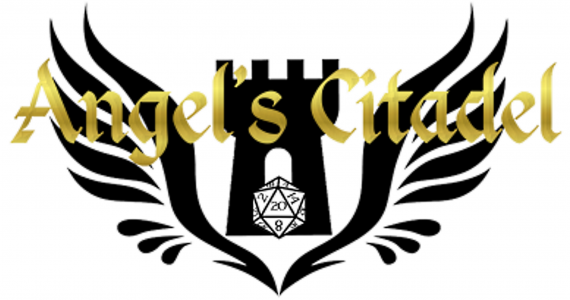
One of the first Kickstarters we backed, we did, to be honest, out of spite. We have mentioned before that both Joann and I come from a heavy background of Cyberpunk and particularly Shadowrun. She and I both really love the lore and the living feel of the world. The rules have always been clunky, however, and with the purchase of that property and two subsequent revisions that we purchased that took things even further into the clunky and finally into the absurdly bad, we both gave up. We decided that we needed another way into that genre. We had both looked at R. Talsorian Games’ Cyberpunk 2020 and even eventually purchased Cyberpunk Red when it came out, but it too seemed rules-heavy and too complicated for the narrative games we liked to run and play in.
Then, Steve Grodzicki of Pickpocket Press announced that he was going to create a cyberpunk and sorcery game based off the system that he used for Low Fantasy Gaming. That game was Kickstarted as LowLife 2090. The Kickstarter was wildly successful generating almost $19,000 while only requesting $5000. Three additional adventures and a GM screen were added as stretch goals, the screen and two of which have come out to-date. We have been playing around with early release copies for quite a few months and even have a live play with the system. We finally got the Premium Color print on demand copy in our hands, though just in advance of the anticipated price hike on those printings by DriveThruRPG’s publishing company, so let’s take a look at what we’ve got!
Manufacturing and Production
The presentation of the book is excellent. Despite having to get used to the font choice, particularly for the section headers and the table columns, it feels clean and thematic. The artwork, all commissioned, is very thematic and has some excellent choices for the material. The printing and binding of the book are excellent, with the only issue being what seems like a slice in the spine of the book part of the way that delaminated it a little. I am unsure, to be honest, if that happened as a result of printing or shipping. It does nothing to reduce the usability or the overall beauty of the book for me, though. The page quality of the print on demand is good, with good, non-smearing ink and sturdy paper.
Content

Characters in LowLife 2090 (called Lifers) are one of six races: Human, Dwarf, Elf, Skorn (something like Orcs), Minotaur, and Spriggan (akin to Goblins). Nine classes compliment those races: Brawler, Exarch (something like a Shadowrun Physical Adept), Entech (something like a Shadowrun Rigger but focusing primarily on gadgets), Gunhand, Hacker, Infiltrator, Influencer (the Face of the party), Mage, and Vex (Vehicle EXpert). Organized very similar to character creation in Low Fantasy Gaming, there is seriously a lot of depth and room for different feeling characters (even if they are the same class) here, which I like. The possible exception to this is the Vex, which feels fairly one-track, but the other eight classes seem to have a fairly decent amount of play-range. Class levels are capped at 10 to keep the game from getting too far off the “desperate” scale of cyberpunk.
There are several different types of rolls in the game. An attribute check is a roll-under check. You roll a d20 and if you get under the target attribute (which can be modified up with a skill), you succeed. If you get less than half of what you need, you get a great success. For example: Your Minotaur Brawler needs to make a strength check to pry open a stuck door. Your Strength score is 18. There are no modifiers. You roll a 7. This is less than half of what you needed (9 is half). So perhaps the GM rules that not only do you pry it open, you are able to do so quietly so as not to alert the guards down the hall. Lifers also have access to a reroll pool that allows them, if they have a relevant skill, to reroll a failed attribute check. This pool goes up by one die every two levels.
The next type of roll is an attack roll. This works similar to a standard d20 game. Roll 1d20, add your class attack modifier and either your Strength or Perception modifier (depending on if you are making a melee attack or a ranged one). If it beats the other character’s Defense, it is a hit. Damage is reduced by armor rating. A word of warning: LowLife 2090 as-written is a violently fast game. Hit points are low, damage from guns is high. If you choose to get into a firefight, make sure you make liberal use of cover, overwhelming odds, and that you choose your battlefield carefully.
The third kind of roll is a Luck roll. Used primarily as a “saving throw”, this can be modified by a skill. The different thing about your Luck score: it goes down (to a minimum of 5) as you use it successfully, to be refreshed during downtime periods between jobs (not a session). The typical highest luck score you can have is 14 (it goes up by table and level, not as an advancement choice).
Similar to Low Fantasy Gaming, LowLife 2090 also has the concept of dangerous magic. The mage, casting from his grimoire, must deal with the potential for Dark Flux. The potential for these effects which range from almost comical to downright uncomfortable and horrendously bad increases the more you use magic on a given job. Honestly, I love this idea, but both Joann and I are big fans of the concept of “magic at a cost”.
One of the other interesting things I found in this game is a “structured” downtime done between jobs. I found that doing so encourages players to get their characters involved in the larger world outside of their actual adventures on a job and as a result, the world feels more alive. The downtime activities are:
- Downtime Expenses – Everyone got bills to pay, hoda.
- Heat Adjustment – Adverse third party interest in the crew waxes or wanes.
- Recovery – Lifers with Addictions, Madness, or Persistent Injuries must spend some time dealing with them.
- Update Network – Strengthen ties, burn bridges, or build new ones.
- Advancement – Lifers that survive a job gain a class based improvement.
- Three Activities – Each PC may engage in up to three misc activities per cycle, including Gear Purchases, Research, Repairs, Crafting and Training. If a player has something else in mind, the GM makes a ruling using the following as a guide.
- GM Special: The GM is free to add their own benefits, twists or complications during Downtime, based on game world events. For example, an old favour might be called in, the crew learn that an infamous Regulator is hunting them, and so on.
The result is a good mix of “worldbuilding” activities, and “personal development” activities, offering ways to round out the character’s (and player’s) experience as a Lifer.
The back portion of the book is GM tools and a summary overview of a sample city to get your Lifers started called Mendoza City. Filled with tons of tables for random encounter ideas, NPC’s your Lifers might run into and things to spark your imagination. Much like his other products, Steve Grodzicki does an excellent job here trying to give GMs a hand running their games by offering ideas, advice, and ways to make the setting feel more cyberpunk and gritty.
Critique
I am going to preface this critique and state that this is only my opinion (OK, well, mine and Joann’s). While we both like the simplicity of LowLife 2090’s system, there is one issue that we see with it. The bulk of the time, characters in a cyberpunk game like this one are put in situations by their GM where they end up having to “mix it up” with the opposition. I mean, there is a reason that there are 3 classes that, for all intents and purposes, are martial classes (Brawler, Exarch, and Gunhand).
The problem here is that with the lethality of the combat in this game, character turnover feels high. A game where characters are so squishy doesn’t lend itself to deep character development which is one of the things that both Joann and I look for in our roleplaying. It is interesting to note that Low Fantasy Gaming, which is supposed to feel more lethal than something like a Dungeons & Dragons 5E or Pathfinder 2E is not as lethal as LowLife. So, there are a couple of things that one can do. The GM can start shifting encounters away from combat, however, the kind of society that is typically portrayed in a cyberpunk setting (and that Mendoza City indeed looks like) does not avoid physically lethal responses to intrusion or crime where money is involved. While you might be able to do this to a certain extent, you will never get away from combat in cyberpunk. And you shouldn’t. It’s part of the flavor.
The second option is to make combat less lethal. Here too, you have a couple of options. Increase hit points (or decrease weapon damage – essentially two sides of the same coin), or increase a Lifer’s ability to shrug off damage (either through armor rating increase per monetary investment or some kind of “special” regenerative method accessed through the “resting” process. Either way, the game achieves its goal of feeling lethal, but that lethality diminishes the ability to get at the portion of cyberpunk that both Joann and I really loved in the process.
Summary
LowLife 2090 is a game of cyberpunk and sorcery by Steven Grodzicki of Pickpocket Press, the company that brought you Low Fantasy Gaming (that we have already reviewed on our site). Playing in the same arena as Shadowrun, Cyberpunk Red, Interface Zero, and other similar dystopian future titles, LowLife does an excellent job of standing up on its own two feet. The mechanics themselves are simple, streamlined, and play quickly, with a wide range of ability choices that keep the characters feeling fresh and different from each other. And while there are some concerns that we personally have with the style of games and stories we like to tell, the system is simple enough that homebrewing a solution that is viable to be able to tell those stories, should be a fairly simple matter. I’m going to recommend this as a must-purchase if you’re in the genre. Sadly, since writing this review, the price for the Print on Demand premium format through DriveThruRPG has gone up drastically, so I cannot recommend going that route. The PDF, though, is ABSOLUTELY worth it. Happy gaming!
- Josh Walles

Thanks so much for doing this Josh, super glad you guys liked it! Hehehe yes LL 2090 is quite deadly but totally agree it would be easy to tweak the rules to make it more survivable. One clarification, not all of the art is commissioned, some is (very excellent) stock art. Alas for the Lightning Source/DTRPG Premium Colour price hike on 1 July – as a result we are in the process of proofing the Standard Colour hardcover – with a bit of luck it will be available end of this month, at a great price.
LikeLike
I’m hoping so too. I mean, we got yours with the Premium Color, but we order a decent amount of PoD stuff through DTRPG, and I will be sad that the “quality” of the images and the ink will be lesser… C’est la vie, I suppose.
LikeLiked by 1 person
Thanks for the review. Much appreciated. PDF now in the Cart.
LikeLike
Awesome! Hope you enjoy as much as we did.
LikeLike